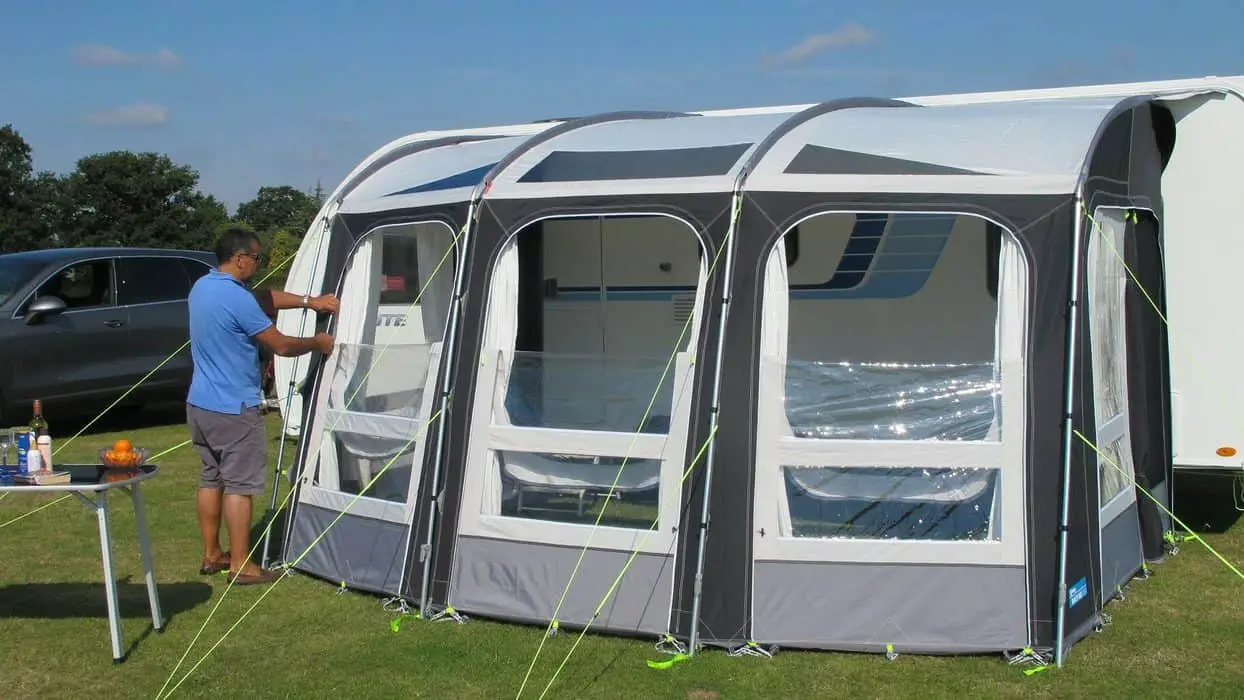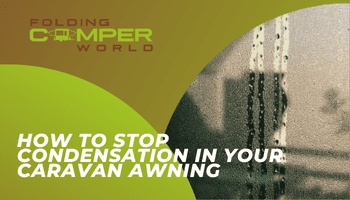Condensation is a common dilemma for many campers in the modern day. This is because modern caravan awnings are made from very lightweight materials that tend to experience condensation more than the heavier weight materials. Sometimes, there can be so much condensation that it can often be mistaken for a leaking awning. In climates like here in the UK, it is difficult to completely avoid condensation due to the amount of rain. The moisture in the air naturally leads to condensation, which is why it’s so important to ensure your try to keep your awning condensation free.
There are several ways you can prevent condensation from building up in your caravan awning. These include ensuring that your awning is kept well ventilated, pitching your caravan where there is a light breeze, and most importantly, wiping down the condensation when you notice it. These are just some effective ways you can prevent condensation in your awning. I will be outlining more ways you can prevent condensation further in the blog post and explaining the causes of condensation to help you understand where the condensation in your awning may be coming from.
This blog post will cover the following:
Why condensation can be harmful

Condensation results from the natural process that occurs when your awning’s moisture content and temperature change. When the temperature falls, the moisture in the air condenses, which can be seen on the colder surfaces of your awning, such as the windows. An everyday example of this is when you take a cold drink out of the fridge on a hot day and condensation forms around the outside edge of it. This is the result of the hot air meeting the cold glass and the water vapour in the air condensing into a liquid format. This is the same thing that happens in your caravan awning.
Condensation can be quite problematic. Not only is it uncomfortable to be in an awning that is covered in condensation, but if it builds up in your caravan awning quite regularly and you don’t wipe it away or do anything to prevent it, it can eventually lead to damp in your awning and even inside your caravan. This can cause your caravan and awning to deteriorate and lose value. The condensation itself is not what causes the structural damage to your caravan, but the effect of the damp is what can cause these issues. It’s also important to note that damp can affect your respiratory health. The spores.
The causes of condensation

Numerous things can cause condensation in your awning. As explained previously, the weather is one of them. If you’re in a cold and wet climate, The moisture in the air can cause your awning to experience condensation. Similarly, if the weather has been wet, and you pitch your awning on wet grass, the moisture from the ground can also lead to condensation. Here are some other common causes of condensation in caravan awning:
- People sleeping in the awning – If you use your awning as extra sleeping space, this could be a reason why there is so much condensation in your awning, as an adult can easily produce up to 1L of water over 12 hours through breathing. This appears as condensation in your awning.
- Heaters being used in the awning – When you use a heater, it causes the moisture in the air and in the ground to evaporate and condense onto the cooler surfaces around your awning. This condensation can usually be seen on the plastic windows of your awning.
- Cooking in the awning – Gas will create water vapour when you burn it, which cannot escape easily due to how waterproof your awning is. If you have to cook in your tent awning, ensure your awning is well ventilated. This will allow some moisture to escape the awning easier, reducing the effects of condensation.
- Storing wet items – If you store wet items in your awning, it can lead to condensation as the moisture from the wet items will evaporate as the item dries, which leads to condensation. These include wet coats, jackets, towels or even wet dogs. This means it’s never a good idea to use a clothing rack to dry your washed clothes inside your awning, as this will create a lot of condensation.
- Rainfall – Wet or damp weather is one of the most common reasons for condensation in caravan awnings. Cold rain can rapidly lower the temperature of your awning material while the temperature remains warm inside the awning. When the warm air comes into contact with the cold material, it creates condensation.
- Sewn-in Groundsheets – These also trap condensation inside the awning, as they don’t allow the excess moisture in the air to exit easily. If your awning has a sewn-in groundsheet, you can expect to experience more condensation; however, they offer adequate protection and allow you to have a bug-free and draught-free camping experience.
Preventing condensation

To find out how caravan users prevent their awnings from getting condensation, I asked users on the Practical Caravan forum how they kept their awnings condensation free. User ‘otherclive’ said
“Condensation can occur more when you have cooler nights. Lightweight awning materials suffer more than heavier weight materials. It needs plenty of nighttime ventilation. I would also open the window zips at the top to let in more air ventilation. Some makers of lightweight awning sell secondary “roof” panels aimed at reducing condensation. But they seem to get mixed reviews.”
The secondary roof that the user refers to here is roof linings. They are available for many awnings, which help reduce condensation by regulating the temperature inside the awning and catching any drips that fall from the roof. They allow the water to dissipate when the conditions improve. You can find out more about roof lining on your awning manufacturer’s website. Here are some other simple ways you can prevent condensation in your awning.
- Avoid pitching on wet ground, especially if it’s wet grass.
- Good ventilation – Having airflow in your awning will reduce the humidity inside the awning.
- Turning off heaters used in the awning.
- Avoid storing wet items inside the awning.
- Ensure you have a breathable waterproof groundsheet rather than a sewn-in one – This stops the moisture coming from the ground and condensing within the awning.
Now that you know what causes condensation and how you can prevent it in your caravan awning, You should be able to ensure your awning is kept in good condition and can use for awning for many more years.


